The National Veterans Shrine and Register of Honor was dedicated February 17, 2014 at the American Village in Montevallo, Alabama. The American Village is a 183-acre history and civic education center founded which opened in 1999. The Shrine is patterned after Philadelphia’s Carpenters Hall, site of the first Continental Congress in 1774. In the words of American Village Founder and CEO Tom Walker, ‘The work of the National Veterans Shrine is telling the stories of hundreds of thousands of patriotic men and women who have served in the Armed Forces of the United States of America. We owe them not only our memory, but by our words and deeds, our thanks, respect and honor.’
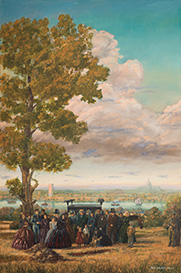
Taps (4’ x 6’)
The artist has recreated a touching setting of one of the first burials at what is now Arlington National Cemetery in the late 1860s. A lone bugler in the lower right of the painting has just finished sounding the song Taps. The bereaved, accompanied by the faithful family dog, are gathered around the gravesite. Benediction is soon to follow.
Beyond the grave, across the Potomac, is the capital city Washington. From the left to the right one sees a panorama: the White House, the still-incomplete obelisk that will become the Washington Monument, the Smithsonian “castle”, and the resplendent United States Capitol, with its newly completed dome.
 Come Ye Blessed (4’ x 6’)
Come Ye Blessed (4’ x 6’)
Set amidst a rural church and its burial ground is a father who has received the flag that draped the coffin in honor of his son who gave his life for our country and its freedom. Supporting the father is his daughter and grandson, and in the background, other family members and friends.
A headstone in the foreground inscribed with the words “Come Ye Blessed” reflects the hope of the faithful of new and everlasting life and is taken from the Gospel of Matthew: “Then shall the King say unto them on his right hand, ‘Come, ye blessed of my Father, inherit the kingdom prepared for you from the foundation of the world.’” The golden sky imbues the surrounding Alabama countryside.
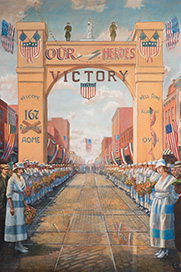
Heroes’ Welcome (4’ x 6’)
The May 10, 1919, parade in downtown Birmingham AL to welcome home “Alabama’s own” — the men of the 167th Infantry — from their service in World War I is the subject of this painting. Thousands of men, women, and children rode streetcars or walked from all parts of the city to welcome their heroes — their loved ones, neighbors, and friends who had answered their country’s call.
Inspired by old photographs and accounts, the painting captures the anticipation of homecoming and a sense of pride and gratitude to our heroes for their service.
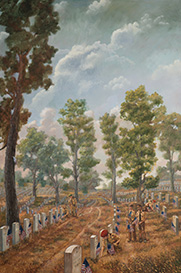
Duty and Honor (4’ x 6’)
Early in the morning on important national days of remembrance like Memorial Day and Veterans Day, many Americans make a pilgrimage and gather at a nearby cemetery to decorate the graves of American veterans with United States Flags.
Those who journey and pay such homage consider it both a duty and an honor to do so. Here the artist captures a Helena, Alabama Boy Scout troop keeping this tradition.
The placement of the Flag of our country on the grave of one of its defenders is an honorable act of service. We pause, we remember, we thank, and we give honor to those whose service and sacrifice secured our Nation’s independence and liberty.
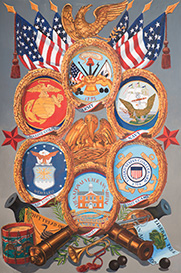
To All Who Served (4’ x 6’)
The artist depicts the National Veterans Shrine with the dedication of the Shrine emblazoned on a banner: “Dedicated to the Men and Women of the Armed Forces of the United States of America, MMCIX.”
This dedication is surrounded by the artist’s vibrant portrait of the service seals of the Armed Forces of the United States, embellished by familiar symbols of the United States of America. The artist draws upon medieval Christian tradition depicting the pelican’s self-sacrifice — puncturing her own breast to provide blood to nourish her young — as a powerful symbol of the sacrificial service and commitment of our Nation’s veterans and active military.
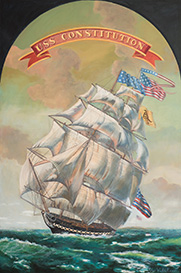
The USS Constitution on the Boisterous Sea of Liberty (4’ x 6’)
Named by President George Washington in 1797 to honor the Constitution, the USS Constitution is the oldest commissioned naval vessel afloat. She is America’s “ship of state” and represents the country. In a pivotal moment in World War II, President Franklin D. Roosevelt penned a note to Britain’s Prime Minister Winston Churchill, quoting Longfellow’s poem:
Sail on, 0 Ship of State!
Sail on, 0 UNION, strong and great!
Humanity with all its fears,
With all the hopes of future years
Is hanging breathless on thy fate!
In the background is the Star-Spangled Banner flying at Fort McHenry, MD. The title of the painting also refers to Thomas Jefferson’s observation that “…the boisterous sea of liberty is never without a wave.” The painting symbolizes the Constitution, liberty, and the flag which our veterans and active military defend by their service and sacrifice.
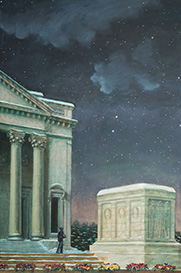
Standing Guard (4’ x 6’)
The artist depicts the guarding of the Tomb of the Unknowns at Arlington National Cemetery. Standing
ard is a Sentinel selected from the United States Army 3rd Infantry Regiment. Since July 2, 1937, the Tomb has been guarded twenty-four hours a day, seven days a week, 365 days a year, no matter the weather or adversity.
Here on this solitary winter night, the haunting sound of the twenty-one step cadence falls on the snow-crested marble. The Tomb Guard alternates between a march of twenty-one steps and a turn and a pause of twenty-one seconds, in constant rhythm, repeated again and again, until relieved at the Changing of the Guard every hour in winter and every half-hour in summer.
The starry southern night sky depicted behind the Arlington Amphitheatre reflects the appearance of the celestial universe on the night of the National Veterans Shrine dedication, February 17, 2014.
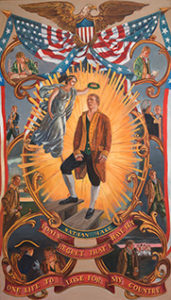 One Life to Lose for Country (4’ x 7’)
One Life to Lose for Country (4’ x 7’)
The artist presents the patriotic story of Nathan Hale in the form of an early 19th century parade banner. The banner presents the story of Washington’s military spy Nathan Hale, who at age 21 was captured and hanged by British forces, just two and half months after the signing of the Declaration of Independence.
Around the banner of vignettes of his life leading to his execution: his being an earnest and beloved student at Yale, his recruitment by a friend to join Washington’s army, his meeting General Washington and agreeing to serve as a spy, and his fateful meeting with a British agent where he was recognized and subsequent arrest by the British, who denied him a Bible, a minister, or a farewell letter to his mother and girlfriend.
In the center of the painting, Hale steps up to the gallows, where Liberty places a crown upon his head, as he declares, “I regret that I have but one life to lose for my country.”
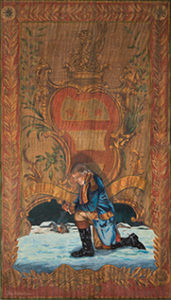 Sacred Honor (4’ x 7’)
Sacred Honor (4’ x 7’)
George Washington is portrayed in his indispensable role as Commander-in-Chief of the Continental Army. He is the embodiment of the extraordinary commitment required by the bold Declaration of Independence for which the delegates pledged “…our Lives, our Fortunes, and our Sacred Honor.”
Reliant on Divine Providence, the Father of Our Country is portrayed kneel- ing in earnest prayer at Valley Forge, just a year and a few months after the Declaration of Independence was signed. In these dark cold months the future of the fledgling nation looked bleak as the ranks of the Continental Army were decimated by cold, starvation, deprivation, and illness.
Behind Washington, the artist depicts the coat of arms of the Washington family, symbolizing the pledge of his “sacred honor” to this cause. The motto is translated by Washington’s Mount Vernon as “The outcome is the test of the actions.” The pledging of sacred honor meant a pledge of the very character, integrity, and good name — the very essence and substance of a person. To risk one’s sacred honor was equally as sacrificial as risking one’s life. Such was the deliberate commitment of Washington and the Founders.
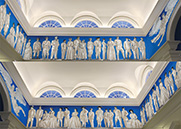 The Cloud of Witnesses (5’ x 100’)
The Cloud of Witnesses (5’ x 100’)
This painted frieze, depicting fifty-one people of the past, is inspired by Hebrews 12:1 which speaks to being surrounded by “so great a cloud of witnesses.”
In this “cloud of witnesses” are men, women, and children of the past who look down upon Liberty and the Fallen and upon us as well. Representing all walks of life, they ran “with perseverance the race marked out” for them. By acts of service and sacrifice they have passed on to us invaluable gifts, among them our Nation’s independence and freedom. This current generation inherits these gifts and holds them in trust. The sculpture of the fallen is a vivid and compelling example that the price of safeguarding these gifts is high: requiring anew pledges of ‘lives, fortune, and sacred honor.’”
